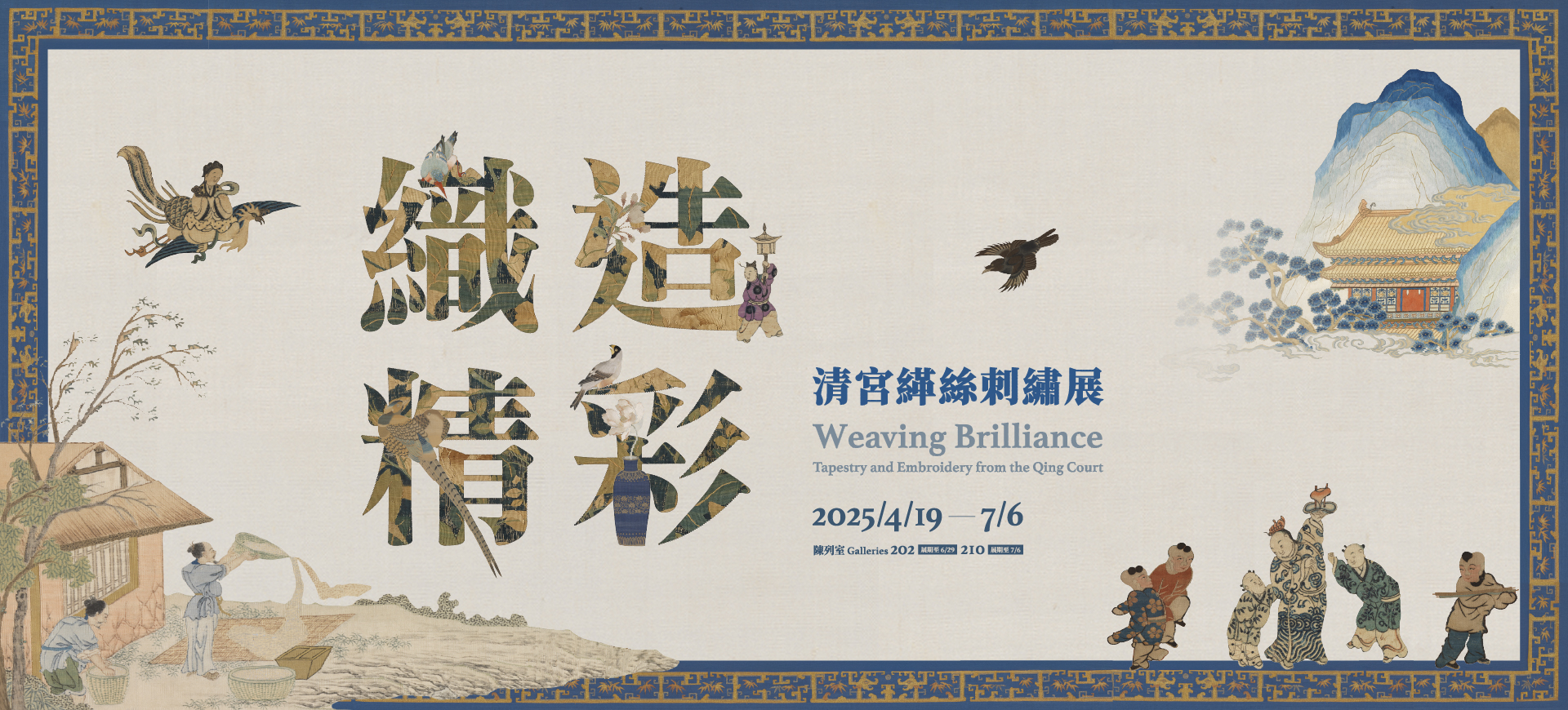Weavings Based on the Emperors’ Calligraphy, Paintings, Poetry, and Prose
-
Kesi of Wishes Fulfilled in the New Year in the Emperor’s Calligraphy
Anonymous, Qing dynasty
Hanging scroll
Gu Si 000093In 1758, Emperor Qianlong appreciated an ink wash painting titled “Depiction of New Year’s Day,” attributed to Dong Xiang of the Northern Song dynasty. The painting features symbolic offerings such as camellias, plum branches, pine leaves, lingzhi mushrooms, persimmons, and lilies—each carrying auspicious meanings such as “everything happening as one wishes” and “evergreen in the cold.” Emperor Qianlong interpreted the composition as a sign of good fortune. In the following years, this theme inspired several imitative works by the emperor and his ministers, including woven replicas produced by the palace workshop. This kesi is one such example.
This kesi piece demonstrates various weaving techniques: contouring brushstrokes are rendered with gou kesi and da kesi, color blocks with ping kesi, camellia petal gradations with mushuqiang, and the layered hues of lingzhi mushrooms with changduanqiang. Notably, gold threads were used to weave the banana leaf and lotus patterns on the flower vase, adding an element of brilliance. The entire piece exudes an elegant and luxurious style, and its woven inscriptions include the phrase “new harmony and auspiciousness; imperial brushwork,” (新韶如意御筆) along with seals such as “Qianlong” (乾隆),”offerings to delight the senses” (清供耳目謀), “fan of pure culture” (扇以淳風), and “fresh colors heralding spring beauty” (新藻發春妍). -
Kesi of the Emperor’s Inscription for the Hall of Nourishing the Heart
Anonymous, Qing dynasty
Hanging scroll
Gu Si 000108Emperor Qianlong (1711–1799), born Aisin Gioro Hongli, reigned under the era name Qianlong from 1736 to 1795 for a total of 60 years. He had a deep passion for literature, was a prolific collector, and often entertained himself with calligraphy and paintings during his leisure from state affairs.
This particular kesi is based on a calligraphic inscription composed by Emperor Qianlong himself in 1750, written in regular script and displayed at the Hall of Nourishing the Heart. According to the Crafts Archives of the Imperial Workshops, in 1775, Emperor Qianlong ordered the Suzhou Weaving Office to enlarge and recreate the inscription of the Hall of Nourishing the Heart in tapestry, exemplifying the trend during his reign of producing textiles centered around the emperor’s own literary works. -
Imperially Commissioned Kesi Shakyamuni Buddha
Anonymous, Qing dynasty
Hanging scroll
Gu Si 000123During the Qianlong period, kesi reached its peak, with large-scale religious paintings becoming one of the dynasty’s defining features. In this particular piece, Shakyamuni Buddha is depicted seated in the lotus position beneath an ornate jeweled canopy, as celestial blossoms rain from above. At the top of the tapestry, a tribute written by Emperor Qianlong in semi-cursive script and woven in gold characters on a blue background dates the piece to 1762. Both the composition and imperial tribute were inspired by the Qing court’s collection of the scroll portrait “Shakyamuni Buddha” by Zheng Zhong of the Ming Dynasty.
The silk threads are consistently fine, with a lavish palette. After weaving, certain areas were enhanced with hand-painted detailing, a hallmark of Qing dynasty kesi. For example, the facial features and body of Shakyamuni Buddha, including the reddish blush of the skin and the tips of lotus petals below, were all painted by brush after the weaving was completed. These hand-applied details contrast significantly in texture with the combed warp-patterned coloration used to weave the five-colored auspicious clouds. -
Kesi Large “Longevity” Character
Anonymous, Qing dynasty
Hanging scroll
Gu Si 000100This large kesi, which bears the label “A Longevity Blessing Titled by the Empress Dowager,” was inspired by the character “壽” (longevity) written by Empress Dowager Cixi (1835–1908). The large red character is adorned with seasonal flowers, including magnolias, peonies, crabapples, orchids, peach blossoms, roses, wisteria, hydrangea, narcissus flowers, lingzhi mushrooms, and plum blossoms. The entire tapestry is densely woven. After the floral motifs and foliage were completed, the artist further enhanced the work by painting and outlining the fine details, demonstrating exquisite craftsmanship.
This design format resembles the style popular in Suzhou prints from the early Qing dynasty onward, where auspicious floral patterns and immortals are arranged within the 2D space created by calligraphic characters such as “福” (blessing) and “壽” (longevity). Compared with the characteristics of Suzhou prints, this piece’s coloration is more subdued yet opulent, embodying the majestic essence of the imperial court.


